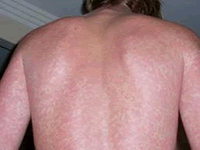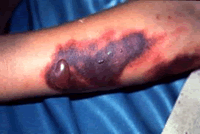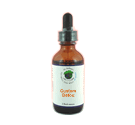 Arthropod/Vector
Bacteria
Chemicals
Fungus /Mold
/ Yeast Metals Parasites Virus Other Arthropod/Vector
Bacteria
Chemicals
Fungus /Mold
/ Yeast Metals Parasites Virus Other
|
Dengue
The characteristic symptoms of dengue are sudden-onset fever, headache (typically located behind the eyes), muscle and joint pains, and a rash. The alternative name for dengue, "break-bone fever", comes from the associated muscle and joint pains. The course of infection is divided into three phases: febrile, critical, and recovery. The febrile phase involves high fever, often over 40 °C (104 °F), associated with generalized pain and a headache, usually lasting two to seven days. During this stage, a rash occurs in approximately 50–80% of those with symptoms. If it occurs in the first or second day of symptoms, you will experience flushed skin, later in the course of illness (days 4–7), you develop a measles-like rash. Some petechiae (small red spots that do not disappear when the skin is pressed, which are caused by broken capillaries) can appear at this point, as well as some mild bleeding from the mucous membranes of the mouth and nose. The fever itself is classically biphasic in nature, breaking and then returning for one or two days, although there is wide variation in how often this pattern actually happens.
The recovery phase occurs last, with absorption of the leaked fluid into the bloodstream. This usually lasts two to three days. The improvement is often striking, but there may be severe itching and a slow heart rate. During this stage, fluid overload may occur. If it affects the brain, it can cause a reduced level of consciousness or seizures. Dengue can occasionally affect several other body systems, causing its own set of symptoms in addition to the classic dengue symptoms. A decreased level of consciousness occurs in 0.5–6% of severe cases, which is attributable either to infection of the brain by the virus or indirectly as a result of impairment of vital organs, for example, the liver. Other neurological disorders have been reported in the context of dengue, such as transverse myelitis and Guillain-Barré syndrome. Infection of the heart and acute liver failure are among the more rare complications. The incidence of dengue fever has increased dramatically since the 1960s, with around 50–100 million people infected annually. If you are traveling to an area where you may be exposed to this condition, consider the Dengue Remedy along with the Mosquito Detox remedy. |
|



